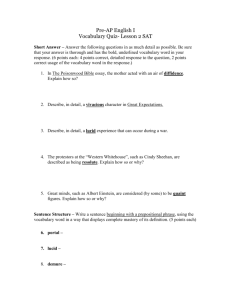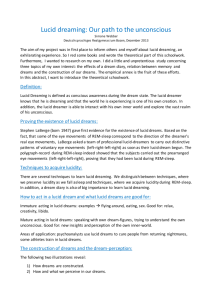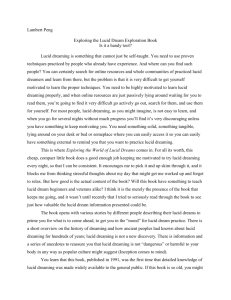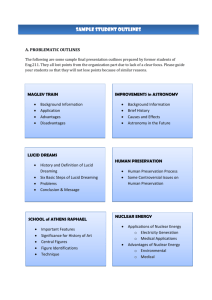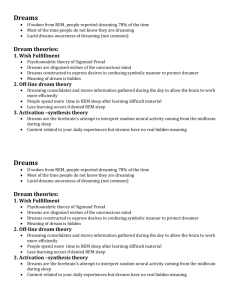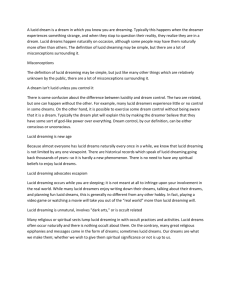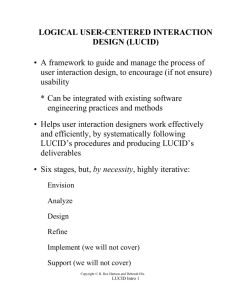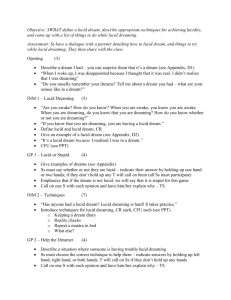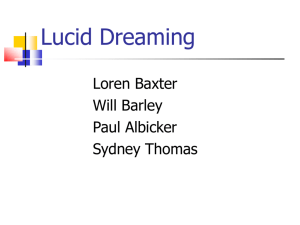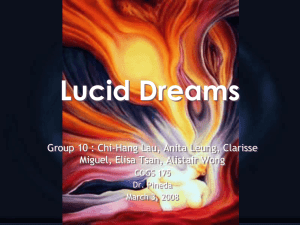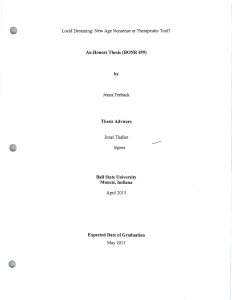Group 9: Lucid Dreaming
advertisement
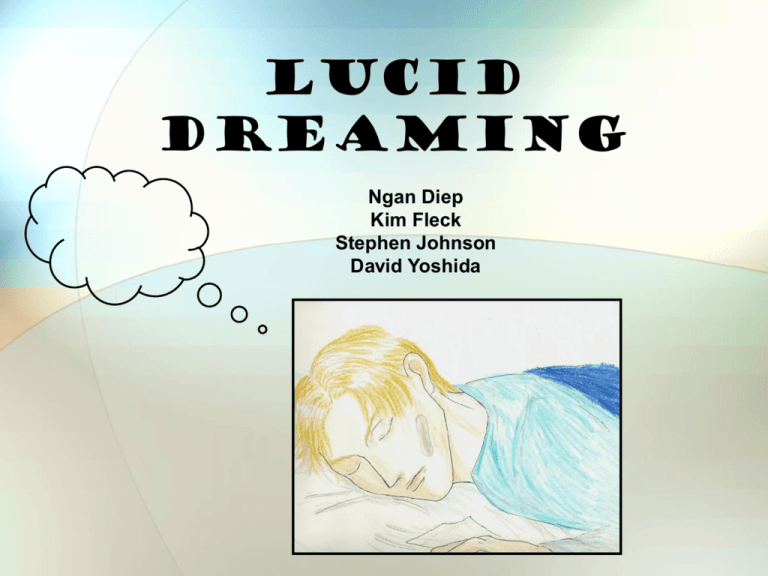
LUCID DREAMING Ngan Diep Kim Fleck Stephen Johnson David Yoshida Outline • • • • • • • • Discussion Questions Introduction History Characteristics of Lucid Dreaming Physiological Aspects Usefulness of Lucidity Methods of Induction Conclusion Discussion Questions • Could there be consciousness during sleep? • Do we have deliberate control over our actions in dreams? • What is the nature of imaginary worlds? • Is lucid dreaming an altered state of consciousness? Introduction • What is lucid dreaming? • Dreams in which you know that you are dreaming. • Levels of lucid dreaming and awareness • High-level lucidity • Low-level lucidity • How common are lucid dreams? • "About 58% of the population have experienced a lucid dream at least once in their lifetime, while about 21% report it with some frequency (one or more a month). – Jayne Gackenbach History • 415 AD written in a letter by St. Augustine. • Practiced by Tibetan Buddhists for a thousand years through a form of dream yoga • 1913 Term coined by Frederick Van Eeden • Modern research- Stephen LaBerge and Lynn Nagel of Stanford University CHARACTERISITICS • The beginning of lucidity is marked by distinct eye movements • Occurs late during the REM sleep cycle • Induced by some sort of “cue” • Recognition of this “cue” is made possible by higher cortical arousal • Waking up from a lucid dream feels more real than waking from a normal dream • This is due to the higher cortical arousal experienced during lucid dreaming PHYSIOLOGICAL ASPECTS • Is there a correspondence between actions of the dreamer and muscle activity and electrical responses? • Dream Actions • (Schatzman, Worsley, and Fenwick 1988) • Dream Sex • (LaBerge, Greenleaf, and Kedzierski 1983) Usefulness of Lucidity • Adventure and Excitement • Practice/Rehearsal • Creative Problem Solving • Therapeutic What is the nature of the dream world? Methods of Induction • Mnemonic Induction of Lucid Dreaming (MILD) • Mindfulness • External Signals • Electric Shock to the wrist • Dream Light (LaBerge 1985) How long do dreams last? Conclusion • Is lucid dreaming an ASC? YES • How long do dreams take? About 13 sec • Is there a correspondence between actions of the dreamer and muscle activity and electrical responses? YES • What is the nature of the dream world? We don’t know. References • Blackmore, Susan. Lucid Dreaming: Awake in Your Sleep? Skeptical Inquirer, 1991. 362370. • Conscious Mind, Sleeping Brain: Perspectives on Lucid Dreaming. Ed. Gackenbach, Jayne and Stephen LaBerge. New York: Plenum Press, 1988. • Holt, Doug. LUCID DREAMING. Philadelphia. 1998. http://serendip.brynmawr.edu/bb/neuro/neuro98/202s98-paper1/Holt.html • LaBerge, S., Greenleaf, W., & Kedzierski, B. (1983). Physiological responses to dreamed sexual activity during lucid REM sleep. Psychophysiology, 20, 454-455. • LaBerge, Stephen and H. Rheingold. EXPLORING THE WORLD OF LUCID DREAMING. New York: Ballantine. 1990. http://www.lucidity.com/EWLD6.txt • LaBerge, Stephen. Lucid Dreaming. New York: Ballantine. 1985. http://www.lucidity.com/LD8DFM.html • Schatzman, M., A. Worsley, and P. Fenwick. 1988. Correspondence during lucid dreams between dreamed and actual events. In Conscious Mind, Sleeping Brain, 155-179, ed. J. Gackenbach and S. LaBerge. New York: Plenum. • Sparrow, G. S. LUCID DREAMING, DAWNING OF THE CLEAR LIGHT Virginia Beach: A.R.E. Press, 1976. • Wallace, Benjamin, and Leslie Fisher. Consciousness and Behavior. Waveland press. 2003.
